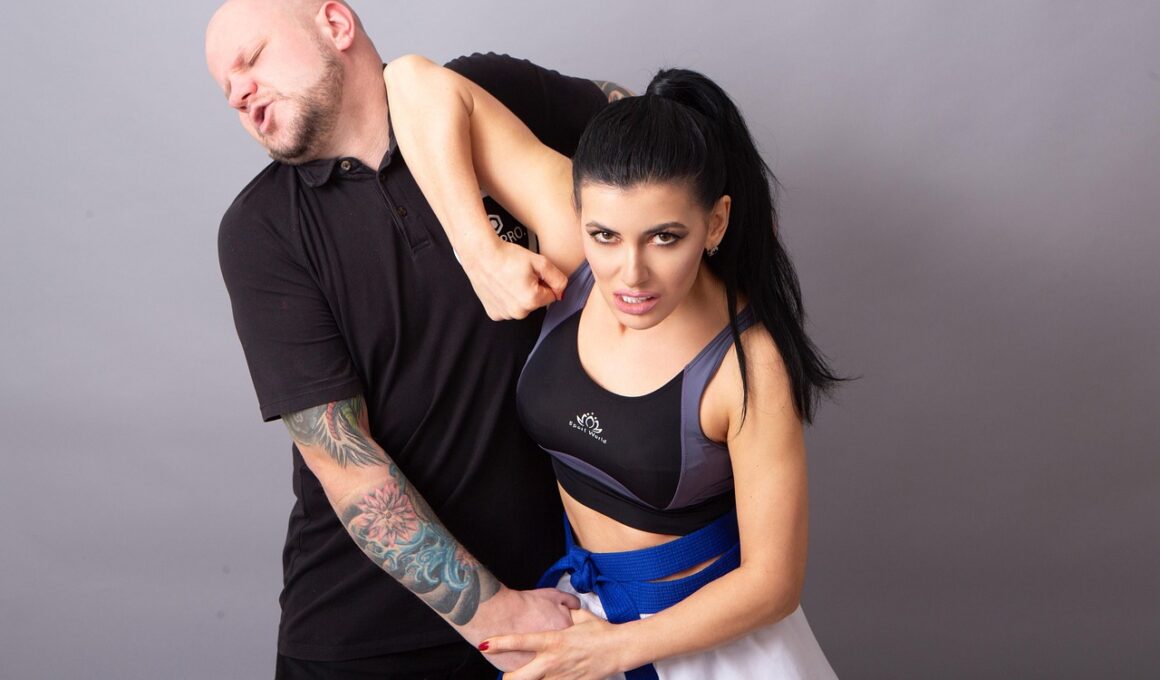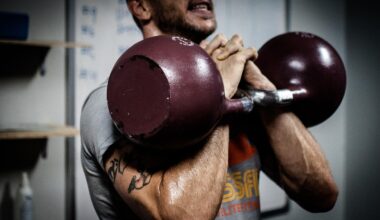Top 10 Exercises to Improve Strength for Self-Defense
Strength is crucial for effective self-defense; it allows individuals to protect themselves more efficiently. Incorporating a variety of strength-building exercises into your fitness routine specifically enhances your physical preparedness. First, consider basic bodyweight exercises such as push-ups, which engage multiple muscle groups and improve upper body strength. Next, include squats that aim to build lower body strength, as they activate major muscles like the quadriceps and glutes. Additionally, lunges can help develop balance and core strength, providing stability in self-defense scenarios. Furthermore, integrating planks into your routine can significantly enhance your core’s resilience. A strong core supports overall body strength and coordination, essential for self-defense actions. Remember to combine these exercises with agility drills for optimal performance. These drills sharpen reflexes and response times, which are equally important in confrontation situations. Also, incorporating resistance bands or weights can provide progressive overload, further enhancing your muscular strength. Consistency and variety in your training can keep you engaged while maximizing your strength gains, ensuring readiness for any self-defense situation.
Another effective exercise for building critical strength involves deadlifts, focusing on the posterior chain muscles and core stability. This powerful movement will enhance your lifting mechanics, necessary in self-defense scenarios. Moreover, kettlebell swings work on explosive power and overall conditioning, assisting in executing powerful strikes. Strength training shouldn’t only concentrate on traditional methods; exploring unconventional tools like medicine balls for plyometric workouts can add variety to your routine. These exercises not only improve your muscular strength, but also help in developing vital cardiovascular health. Many self-defense situations rely heavily on stamina and the ability to endure prolonged physical exertion. By combining strength and endurance workouts, you can optimize your performance when it matters most. Complementing strength exercises with regular cardiovascular activities like running or cycling cultivates overall fitness. Furthermore, focusing on flexibility through yoga or dynamic stretching can aid recovery, contribute to mobility, and prevent injuries. As you refine these aspects of your training regimen, regularly assess your progress to ensure you’re consistently improving. This comprehensive approach is paramount for anyone serious about self-defense readiness.
Core Strengthening Exercises
Core strength is the foundation of effective self-defense; thus, incorporating specialized exercises is crucial. Start with activities like Russian twists, engaging the obliques while developing rotational strength. Incorporating ball slams can also be beneficial, as they improve power and strength with explosive movements. Consider performing mountain climbers, which boost cardio while focusing on core activation and overall conditioning during self-defense engagements. Also, don’t overlook the value of back extensions, particularly for building resilience in the posterior chain while improving posture. Stability exercises such as the bird dog further enhance proprioception and balance, essential during physical confrontations. Balancing on stability balls can also provide a challenge, emphasizing muscle recruitment and functional movements. To further optimize your core strengthening workouts, consider integrating Pilates-based routines that focus on controlled movements and breath control. As strength is gained, focus should also shift towards functional applications. Understanding how to use newfound strength within various contexts, such as self-defense movements, is essential. Test different combinations and workouts to see what best fits your personal goals while enabling maximum strength development for self-defense.
In addition to core exercises, incorporating upper body workouts is vital. Movements like bench presses or overhead presses help build the strength necessary for powerful strikes. To target the back, engage in rowing exercises, which reinforce the upper body strength essential for grappling encounters. Enhancing grip strength through exercises such as farmer’s walks allows you to maintain control in potential wrestling scenarios. Moreover, don’t underestimate the importance of shoulder stabilization through movements like face pulls; this helps prevent injuries during self-defense maneuvers. Exploring isometric holds, such as the wall sit, can improve muscular endurance in the lower body, preparing you for situations that require prolonged engagement. For well-rounded development, ensure to include various equipment like dumbbells and resistance bands to resist stagnation. Alternating between high-intensity interval training (HIIT) and strength-focused workouts creates an adaptable routine enhancing overall readiness. Utilize rest days to focus on recovery, maintaining hydration and nutrition essential in supporting your journey. Remember consistency is critical, and developing a focused, varied strength training regimen will keep you in peak performance for any self-defense scenario.
Agility and Functional Movement
For self-defense, agility cannot be ignored; it enhances reaction times and mobility. Incorporating agility ladders into your training offers beneficial footwork drills that accentuate quick movement and coordination. Along with footwork drills, exercises like box jumps develop explosive leg strength, valuable in evasive maneuvers. As you implement these drills, remaining light and agile on your feet should be a priority. Adding coordinated routines like shuttle runs cultivates swift directional changes, catering to various scenarios scrambling through dynamic movements. Increasing your cardiovascular fitness through sports or other engaging activities assists in developing both speed and endurance. In unarmed combat situations, strength without agility can be limiting; seamlessly transitioning between striking and defensive moves is crucial. Additionally, integrating purposeful dynamic warm-ups prepares your muscles for training while reducing the risk of injury. Balanced strength, flexibility, and coordination create a well-rounded foundation for combat effectiveness. Prioritizing agility training will ultimately enhance your performance, allowing for more effective responses under pressure. Adaptability in movement will enrich your approach to self-defense, creating a multifaceted training paradigm for optimal self-protection.
Another essential aspect is recovering properly after intense training. Implementing recovery strategies such as foam rolling can alleviate muscle soreness while promoting blood flow to facilitate healing. Nutrition also plays a significant role; focusing on protein intake supports muscle recovery essential for building strength after workouts. Emphasizing hydration will help ensure optimal performance; maintaining fluid balance is critical, particularly when engaging in vigorous training sessions. Stretching after workouts will facilitate flexibility and ensure muscles maintain their elasticity, essential for effectiveness in self-defense scenarios. Additionally, understanding the importance of sleep cannot be overstated, as rest contributes significantly to recovery and performance. Aiming for adequate sleep regularly will allow your body sufficient time to heal and adapt to rigorous training demands. It’s crucial to listen to your body’s signals; recognizing when to reduce training intensity is essential for injury prevention. Customizing a recovery plan specifically focusing on your physical needs will enhance your overall fitness journey. Combining these practices with consistent strength training will ultimately prepare you towards achieving your self-defense goals effectively.
Conclusion and Commitment
To summarize, improving strength for self-defense relies heavily on commitment and consistency. Regularly incorporating various exercises like bodyweight training, resistance workouts, and agility drills will cultivate total fitness tailored for confrontation scenarios. Strength training should not only aim to enhance individual capabilities but also integrate functional movements relevant to potential self-defense encounters. Ensuring a well-rounded approach will enhance overall performance, allowing you to respond effectively under pressure. Seek guidance for proper form and technique in strength training to prevent injuries, ensuring your progress is sustainable. Additionally, measure your progress and be open to adapting your routine based on challenges encountered throughout your fitness journey. Decision to embark on strength training for self-defense can be empowering; it builds confidence alongside physical readiness. Creating a community for encouragement could further amplify motivation, sharing techniques and insights related to self-defense fitness training. Ultimately, stepping towards improving self-defense capabilities through strength training is undeniably a journey worth undertaking for personal safety and empowerment in unpredictable situations. Commit to the process and witness tangible results, driving your confidence and abilities to new heights.
Strength training will provide a strong base for more advanced self-defense techniques; practice applying the strength in tools for protection. Begin with incorporating exercises that build upon the strength gained from these routines consistently. Also, engage in cross-training for agility, flexibility, and speed, ensuring a comprehensive approach to self-defense fitness training. Additionally, always focus on correct technique to maximize training effectiveness while minimizing the possibility of injury. Having a clear self-defense focus in your strength regimen can guide your fitness journey and enhance your capabilities. Collaborate with others in focused training sessions; learn from one another and improve collective skills. Most importantly, make it fun; enjoying the process will make you more likely to stick to your fitness commitment. Celebrate personal milestones, recognizing achievements that foster motivation. As you develop physical strength, remember to cultivate mental strength. Mental sharpness is vital for assessing situations and responding effectively. Strive to develop resilience and fortitude alongside physical training. Pairing physical strength with strategic mindset development is paramount in self-defense contexts. Apply these lessons into everyday life for comprehensive self-defense preparedness.


